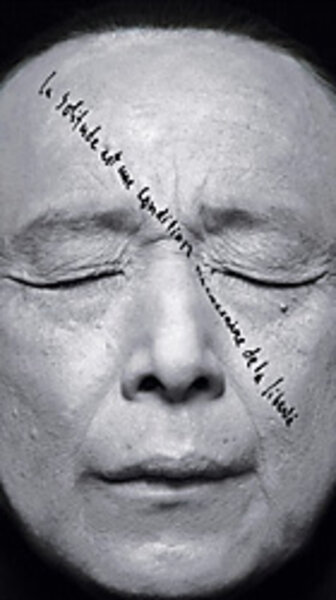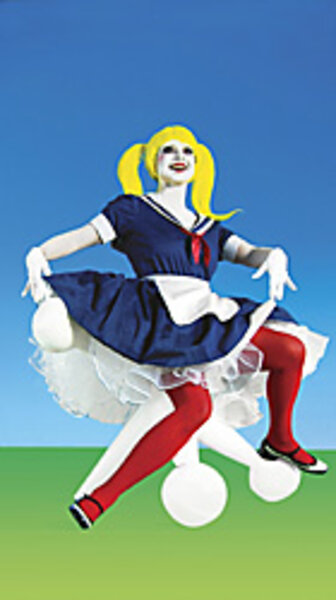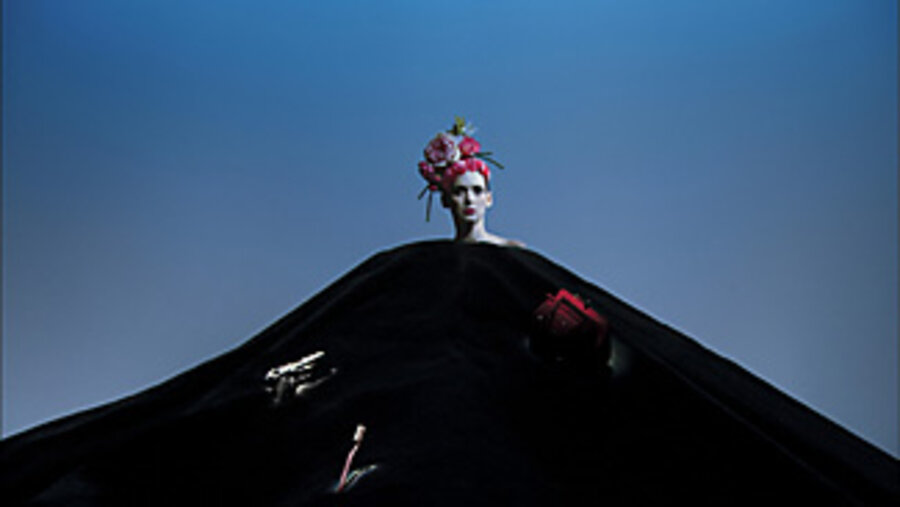Robert Wilson's still lives in motion (barely)
| Iowa City, Iowa
What happens when you take Winona Ryder, Brad Pitt, Johnny Depp, the Queen of Morocco, an auto mechanic, and a panther and put them together in a museum?
For Robert Wilson, the answer is a fresh way of looking at art, and at the big, busy, brash modern world outside.
The Museum of Art at the University of Iowa has assembled a collection of Wilson's work – likenesses ranging from celebrities to poets, from authors to dancers and ordinary people (and animals). The portraits, shot in high-definition video, mount vertically on large plasma monitors, installed in collaboration with VOOM HD Networks, a corporation based in New York. A few hang in the Legion Arts building up the road, in Cedar Rapids. (Both exhibits run through March 30.)
But these are not your typical Renaissance portraits. They move. Not by much: there are blinking eyes, mouths chewing gum, and wind-blown dresses. The familiar figures become a bit unfamiliar and, in some cases, outright strange.
Stepping away from the paint and canvas of the traditional artist, Wilson uses the high-definition canvas of the 21st century. If the portrait painters of the past invited a quiet gaze to map the intricate detail of such still lifes, Wilson has created a new kind of portraiture.
Museum director Howard Collinson says that Wilson's VOOM work is an "amalgam of theatre and the visual arts, and that's what makes his work unique. Each piece can be seen as a small production."
"It's definitely the art of the next century," says Mimi Getachew, a graduate student at the University of Iowa. "When we think of artists we think of old paintings... . Things that are untouchable. This is art for our time. [Wilson] created it during my generation, and during my generation I got to experience it."
Johnny Depp stands before a bright pink wall, wearing a hat with a fur delicately wrapped around his shoulders and face as he stares back at the viewer, occasionally chewing gum. We simultaneously hear the barking of a dog, a ringing phone, a violin, and Wilson speaking lines from T.S. Elliot.
Brad Pitt, in his underwear, stands in blue light in front of a brick wall as falling rain washes over him. The rain stops, and Pitt slowly raises a water gun, and shoots it toward the camera. We hear his voice chanting, "Ready or not, here I come."
"The reason I work as an artist is to ask questions," Wilson says. "That is to say, What is it? And not to say what something is. For if we know what it is that we're doing there's no reason to do it."
The first thing one notices is the stillness. Many visitors to the opening night gala at the museum thought the images were still photographs, until the subject blinked or moved a finger.
Susan Karlman, a museum patron, says she spent a long time staring at a portrait of an auto mechanic, before picking up on a host of tiny movements.
"All of a sudden it started to teeter a little bit back and forth and I wasn't sure if it was me or the picture," she says. "Then, a short while later, it started blinking. So I thought, okay, it's not just me!"
It's these subtleties that Wilson, a career artist, is trying to capture.
"Sometimes, when we're very, very still, we're more aware of movement than when we make a lot of movement outwardly," Wilson says. "So these portraits are exploring this inner movement. It's about a way of listening inside."
Theatre icon of the world stage, Wilson's oeuvre spans from the ground-breaking Philip Glass opera, "Einstein on the Beach" (1976) and hip musical "The Black Rider" (William S. Burroughs and Tom Waits) to classic works of Shakespeare and Wagner's operas. His style is marked by controlled movement and stillness within movement – beauty contained and delineated through formal lines and shapes, Wagnerian in scope but containing John Cage's sensibility for silence.
Raised in Waco, Texas, Wilson dropped out of business school in Austin to study architecture at the Pratt Institute in New York City. The career change came after listening to a lecture by the United Nations economist Noel Muno, who discussed the importance of art to the cultural life of nations. Wilson has since directed projects world-wide, working with performers throughout Europe, Norway, the Middle East, and even Bali.
"My work has always dealt with a kind of space that allows one to daydream... to go to a space that's quiet, that's more meditative," Wilson says during an interview here at the University of Iowa. "People are looking for more of those kinds of spaces as alternatives" to mainstream media.








